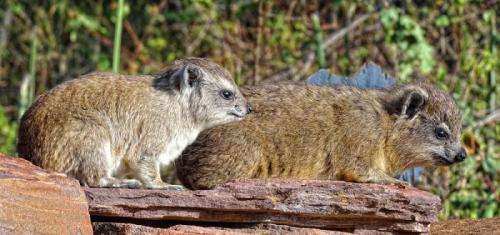February 19, 2013 report
Researchers analyzing hyrax urine layers to study climate change

(Phys.org)—Researchers from Montpelier University in France have discovered a novel way to trace climate change over the past several thousand years—by analyzing layers of urine deposited by generations of the rock hyrax in the mountains of South Africa. The small, guinea pig-sized animal lives among the rocks and crags and tends to urinate in the same spot every time it goes, creating layer after layer of material that is chock full of evidence of climatic change. The study is being led by Brian Chase who reported on the team's findings while speaking at the American Association for the Advancement of Science's annual meeting in Boston.
The rock hyrax actually looks similar to a groundhog but is more closely related to the elephant—it lives in Africa and Asia and doesn't travel. Successive generations living in colonies have populated various nesting areas for thousands of years leaving behind what researchers are only now discovering is an important tool for studying how the climate has changed in areas over very long periods of time. The researchers have found one nest with a urine patch with layers they were able to trace back to 55,000 years ago. Each layer has bits of leaves, pollen, calcium remnants, stable isotopes, charcoal and trapped gas bubbles—all of which can be tested and dated.
Thus far, the team has found evidence to help explain what went on in Africa just after the last ice age—after glaciers melted leaving behind great pools of very cold water that were blocked by mountains in Europe. When the blockages were suddenly broken, all that cold water rushed into the North Sea, causing a nearly instant cooling across Europe. But until now researchers had scant evidence of what occurred in the rest of the world. The urine layers suggest that Africa was cooled as well, hinting that it might have been a temporary global phenomenon. They've also found evidence that contradicts models that show southern Africa was arid approximately 12,000 years ago—the hyrax were eating grasses that only grow in wet climates.
The point of studying how climate has changed in the past, of course, is to help build models that can predict what might happen in the future—something that is becoming particularly relevant as the planet continues on its current trend of global warming.
© 2013 Phys.org



















